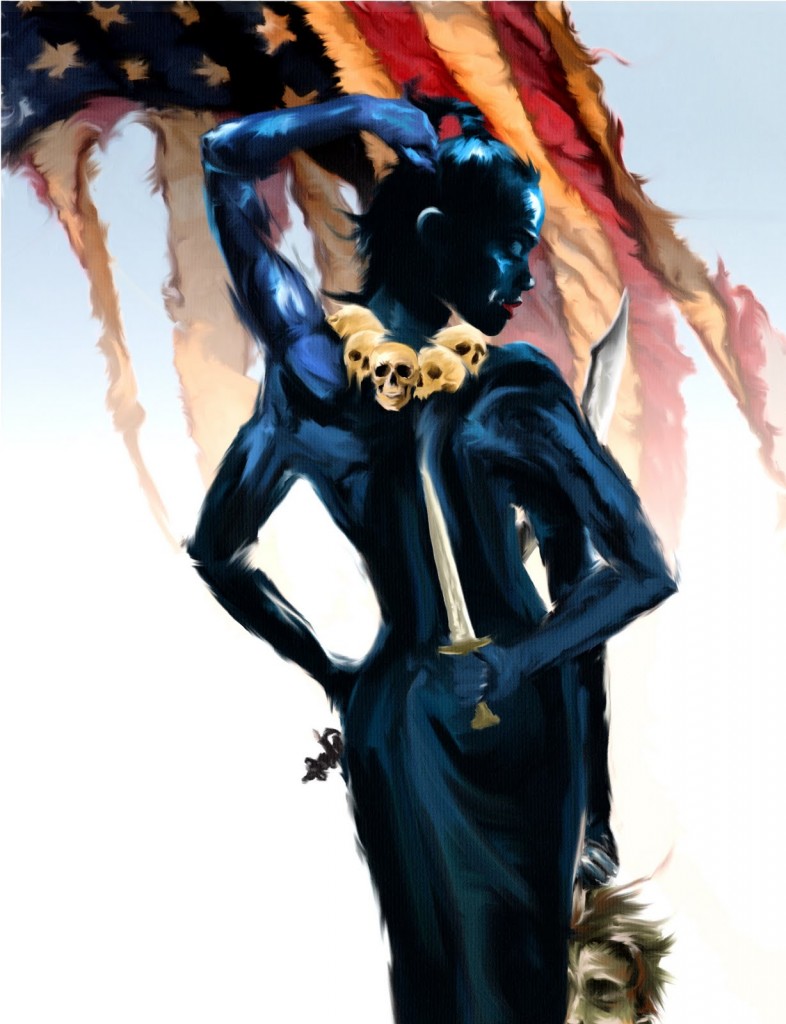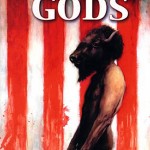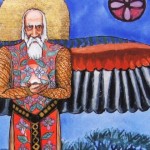
In Part 1, I observed that there has always been a close relationship between fantasy and contemporary Paganism, and for the most part, we Pagans are unashamed of it. A work of fiction may open a person up to having a very real experience to which they were not open before. For example, a person might read American Gods and develop an interest in devotional polytheism, from which they proceed to learn more and seek out a direct encounter with the gods. But saying that works of fiction played an important role in the Pagan revival does not deny that it was inspired by powers which transcend the minds of the authors of those works of fiction. In Part 2, I will discuss the significance of American Gods for understanding the growth of devotional polytheism and dynamics with Paganism generally.
Hard polytheists often balk at the suggestion that devotional polytheism is new. Of course, it isn’t. People have worshipping gods in a devotional fashion for millennia. But the contemporary manifestation of devotional polytheism under the umbrella(s) of the Pagan/Polytheist movement(s) is relatively new. The earliest references I have found in print to what may now be recognized as devotional polytheism is in Janet Farrar and Gavin Bone’s book, Progressive Witchcraft, which was published in 2003. Obviously, Pagans and Polytheists were practicing devotional polytheism before this. For example, Sabina Magliocco has documented that Diana Paxson was experimenting with oracular seiðr and the intersection of Voudun and Heathenry in the 1990s. No doubt there were others. But they were the pioneers. Interest in devotional forms of polytheism appears to have increased exponentially sometime after 2001.
It is possible that the Sept. 11 attacks in 2001 may have played a role in the growth of devotional polytheism, just as it may account for some part of the continued growth of evangelical Christianity. Both devotional polytheism and evangelical Christianity are religions which center on direct encounters with personal gods. (See Tanya Luhrmann’s When God talks back: Understanding the American Evangelical Relationship with God.) Both hard polytheism and evangelical Christianity tend toward a literalistic description of those gods. And both can understood as a collective response to the anxiety caused by tragedy, a desire for an increased sense of stability and meaning, and a dissatisfaction with more relativistic forms of religion. Saying this, though, does not pathologize either of these religions. Rather, as explained in Part 1, it merely recognizes that our religions do not exist in a cultural vacuum.
The year 2001 was also the year American Gods was published. The premise of American Gods is that the gods of polytheism came to American with their immigrant worshipers. They now walk around disguised as human beings. The old gods weakened as belief in them weakened, and they now battle with new gods, gods of the Internet and credit cards and super highways. American Gods was significant for Pagans because it was a realistic and contemporary account of the gods of ancient polytheisms, and many Pagans found it compelling at the time.
One scene in particular is important for the present discussion. It is an encounter between the god Odin, disguised as a human being, who goes by the name “Wednesday,” and a waitress, who is also a feminist goddess worshiper:
“… I’m a pagan,” the woman behind the counter said. …
“Really?” said Wednesday. “… And tell me, as a pagan, who do you worship?’
“Worship?”
“That’s right. I imagine you must have a pretty wide open field. So to whom do you set up your household altar? To whom do you bow down? To whom do you pray to at dawn and at dusk?”
“The female principle. It’s an empowerment thing. You know.”
“Indeed. And this female principle of yours. Does she have a name?”
“She’s the goddess within us all. She doesn’t need a name.”
“Ah,” said Wednesday, with a wide monkey grin, “so do you hold mighty bacchanals in her honour? Do you drink blood wine under the full moon, while scarlet candles burn in silver candle holders? Do you step naked into the seafoam, chanting ecstactically to your nameless goddess while the waves lick at your legs, lapping your thighs like the tongues of a thousand leopards?”
“You’re making fun of me,” she said. “We don’t do any of that stuff you were saying.” She took a deep breath. Shadow suspected she was counting to ten. “Any more coffees here? …”
They shook their heads, and the waitress turned to greet another customer.
“There,” said Wednesday, “is one who ‘does not have the faith and will not have the fun,’ Chesterton. Pagan indeed.”
Here, Gaiman contrasts a vague and metaphorical Goddess feminism with an ecstatic and literal polytheism. What’s really interesting about this scene is how Wednesday’s dismissive attitude toward the Goddess worshiper is reflected perfectly in the attitude of many hard polytheists toward other “softer” forms Paganism. And one must wonder, which came first?
Let’s back up a little and put this in context. In the 1990s, access to World Wide Web grew exponentially, which led to the unparalleled spread of information about Paganism, both ancient and contemporary. The rapid increase in the availability of information on Paganism drove the growth of non-traditional, eclectic, and solitary Paganism. As a result, Paganism experienced a dilution which is the inevitable result of the popularization of any movement. The number of Pagans who had not had an initiatory experience swelled in proportion to the number who had. Exoteric forms of Paganism began to be emphasized over the esoteric forms. And Paganism increasingly became understood as a form of self-expression, rather than a form of self-transformation.
In addition, a consumeristic attitude toward the gods developed. The idea that we create the gods in our own image can be an empowering one. But the downside of this was a trivialization of the divine, what David Rieff called, “Designer Gods,” and others labelled “plug-and-play” polytheism. In the long run, these consciously constructed gods left many Pagans with the empty feeling of staring at themselves in the mirror. Where was the transcendence of self? Where was the connection to the divine “Other”? Where was the ecstasy? (a word which etymologically means “to stand outside oneself”).
All of this was coming to a head around the turn of the millennium. The publication of American Gods also coincided with the “anti-fluffy” movement. In 2001, the term “fluffy” (later “fluffybunny”) was popularized by the author of the internet essay, “Why Wiccans Suck.” The essay was little more than a personal rant against non-traditionalism and eclecticism, but the term caught on, and spurred a seemingly endless stream of anti-fluffy critiques of other people’s Paganism online. Many of these critiques were soon echoed by devotional polytheists.
It is in this context that American Gods came onto the scene, and it is in this context that Wednesday’s criticism of the Goddess-worshiping waitress makes sense. I don’t know how familiar Neil Gaiman was with contemporary Paganism, but I think American Gods reflected — and probably magnified — a dissatisfaction among many Pagans with popular forms of Paganism. And it offered one possible alternative: literal belief in the gods and devotional forms of worship. Popular Paganism was failing to produce the kind deep religious experiences that many of Pagans craved, and devotional polytheism promised to answer that craving.
Of course, not everyone who found popular Paganism wanting became a hard polytheist. Some left Paganism. Others found routes to transcendence and ecstasy under the Pagan umbrella. For example, some became devotional polytheists without becoming hard polytheists. A literal belief in the gods is not a prerequisite to practicing devotional polytheism, as I learned from the Kali Puja ritual at Pantheacon in 2012 and 2014. The Kali Puja ritual, which was led by Chandra Alexandre and Sharanya, was definitely devotional and and definitely theistic; there were expressions of love, gratitude, and surrender to the goddess Kali. Outwardly, the ritual has the form of the worship of a single Indian goddess, but for Sharanya, Kali is an expression of the universal Goddess, the Divine Feminine, which emphasizes her antinomian, relational, embodied, cyclical and chthonic characteristics.
Contemporary Paganism offers other routes to the divine “Other” as well. Earth-centered Pagans can cultivate devotional relationships with the earth and its other-than-human inhabitants without any theistic symbolism being necessary. And there are a multitude of ecstatic Pagan practices that don’t necessarily involve devotion to deities. In addition, there are ways to understand the archetypes as numinous gods and that does not reduce them to mere metaphors or constructions of our conscious minds. (Share the paths you’ve discovered to transcendence and ecstasy in the comments.)
American Gods is now being made into a TV series, which will be airing on Starz next year, so we’re going to be hearing more about it in the Pagan media. The book is important for understanding the rapid growth of devotional polytheism in the last 15 years. But I think it is also important because it shows how the power of our religions can be diminished when we lose sight of the importance of self-transcendence.
















